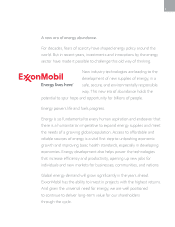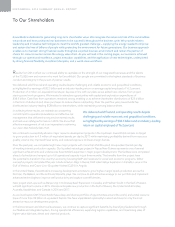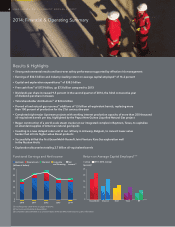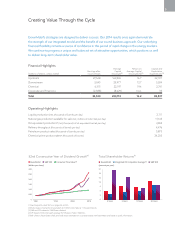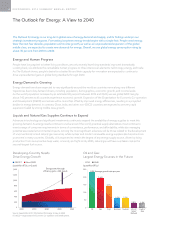Exxon 2014 Annual Report Download - page 8
Download and view the complete annual report
Please find page 8 of the 2014 Exxon annual report below. You can navigate through the pages in the report by either clicking on the pages listed below, or by using the keyword search tool below to find specific information within the annual report.
The Outlook for Energy: A View to 2040
The Outlook for Energy is our long-term global view of energy demand and supply, and its findings underpin our
strategic investment programs. Forecasting long-term energy trends begins with a simple fact: People need energy.
Over the next few decades, population and income growth, as well as an unprecedented expansion of the global
middle class, are expected to create new demands for energy. Overall, we see global energy consumption rising by
about 35 percent from 2010 to 2040.
Energy and Human Progress
People have long aspired to better living conditions, yet only recently have living standards improved dramatically.
Looking back, we attribute this remarkable human progress to three interwoven elements: technology, energy, and trade.
As The Outlook shows, people’s desire for a better life and their capacity for innovation are expected to continue to
drive unprecedented gains in global living standards through 2040.
Energy Demand is Growing
Energy demand trends are expected to vary significantly around the world as countries move along very different
trajectories due to key demand drivers, including population, demographics, economic growth, and income levels.
As the world population increases by an estimated 30 percent between 2010 and 2040, we see global GDP rising by
about 140 percent as all countries experience economic growth. Expansion of the Organisation for Economic Co-operation
and Development (OECD) economies will be more than offset by improved energy efficiencies, resulting in a projected
decline in energy demand. In contrast, China, India, and other non-OECD countries are expected to see very rapid
expansion fueled by strong middle class growth.
Liquids and Natural Gas Supplies Continue to Expand
Advances in technology and significant investments continue to expand the availability of energy supplies to meet this
growing demand. As energy needs continue to evolve around the world, practical supply alternatives must continue to
meet a range of consumer requirements in terms of convenience, performance, and affordability, while also managing
potential associated environmental impacts. Among the most significant advances will be those related to the development
of unconventional oil and natural gas resources, while nuclear and modern renewable energy supplies also become more
prominent in many countries. Globally, oil is expected to remain the largest of any energy supply source, driven by rising
production from resources like deep water, oil sands, and tight oil. By 2025, natural gas will have overtaken coal as the
second-largest fuel source.
OECD(1)
Energy saved through
efficiency gains ~500 Quads
Developing-Country Needs
Drive Energy Growth
(quadrillion BTUs, or Quads)
1,400
1,200
1,000
800
600
400
200
0
Non-OECD
Source: ExxonMobil, 2015 The Outlook for Energy: A View to 2040
(1) OECD = Organisation for Economic Co-operation and Development.
2000 2010 2020 2030 2040
Eric Whetstone • Whetstone Design
EDITOR
Nick Berthiaux • Investor Relations
Exxon Mobil Corporation, Irving, TX
Carol Zuber-Mallison • ZM Graphics, Inc.
studio/cell: 214-906-4162 • fax: 817-924-7784
ATTENTION: OWNER VERSION
APPROVED BY
Feb. 19, 2015
FILE INFO
LAST FILE CHANGE MADE BY
C S06A 14XOM-
GlblEnrgyDmnd.ai
IN F&O ON PAGE
IN SAR ON PAGE
Includes link file
2010 2040
Oil and Gas:
Largest Energy Sources in the Future
(quadrillion BTUs)
250
200
150
100
50
0Oil
0.8% Average growth rate per year
Gas
1.6%
Coal
0.1%
Nuclear
0.5%
Biomass
2.3%
Wind/
Solar/
Biofuels
5.8%
Hydro/
Geo
1.8%
Eric Whetstone • Whetstone Design
EDITOR
Nick Berthiaux • Investor Relations
Exxon Mobil Corporation, Irving, TX
Carol Zuber-Mallison • ZM Graphics, Inc.
studio/cell: 214-906-4162 • fax: 817-924-7784
ATTENTION: OWNER VERSION
APPROVED BY
Jan. 31, 2015
FILE INFO
LAST FILE CHANGE MADE BY
C S06B 14XOM-
EnergyMix.ai
IN F&O ON PAGE
IN SAR ON PAGE
Includes link file
EXXONMOBIL 2014 SUMMARY ANNUAL REPORT
6



